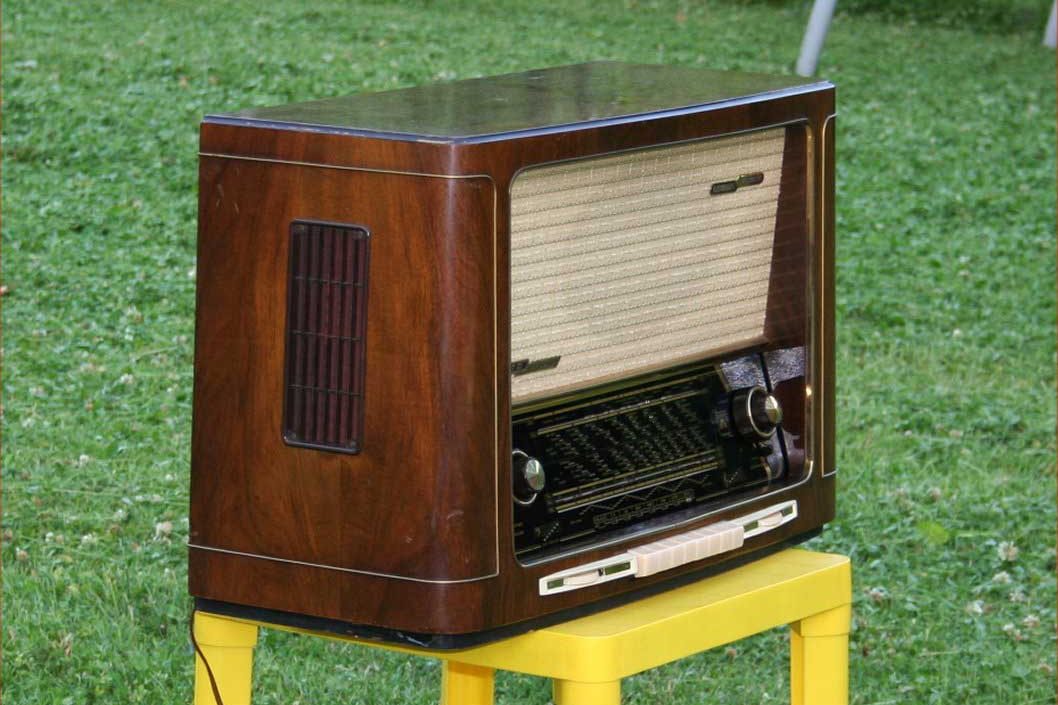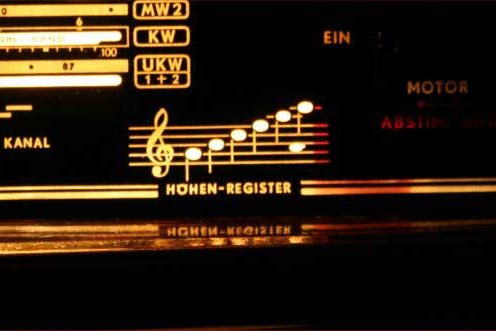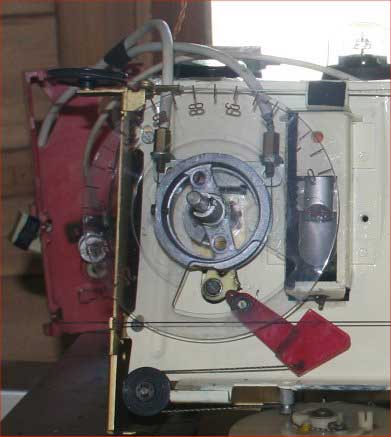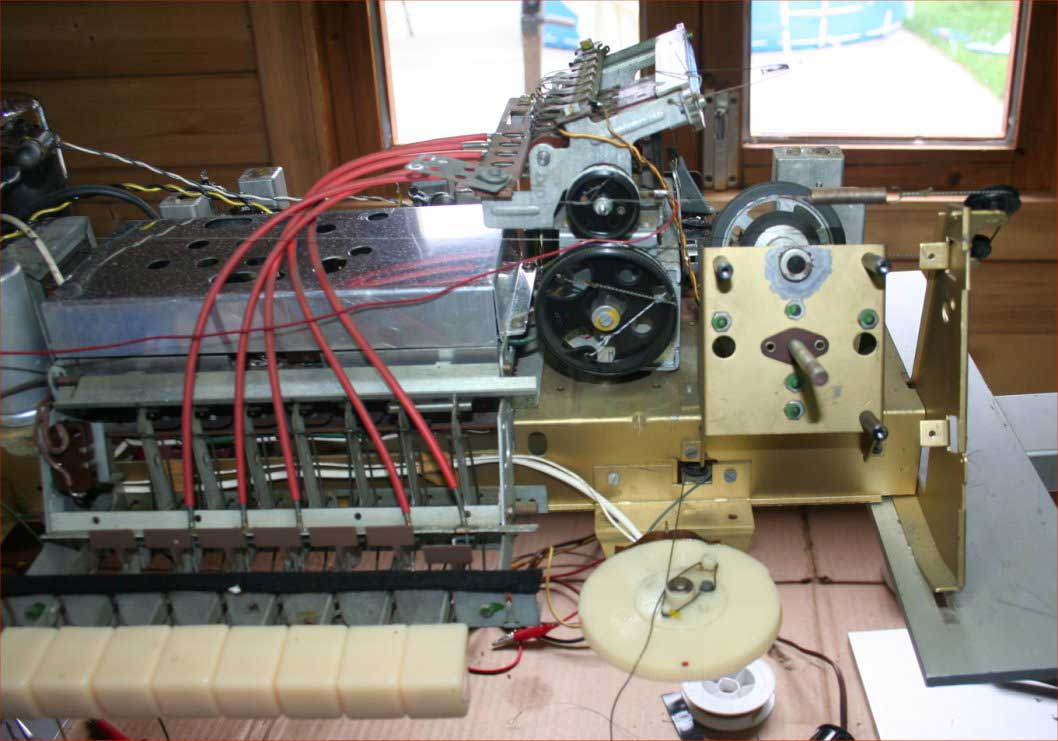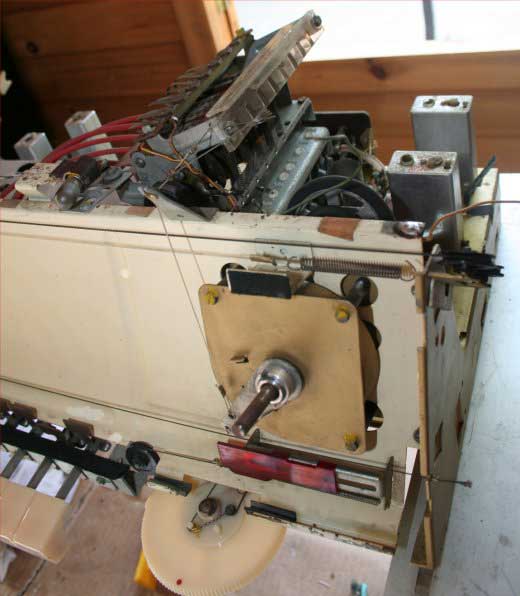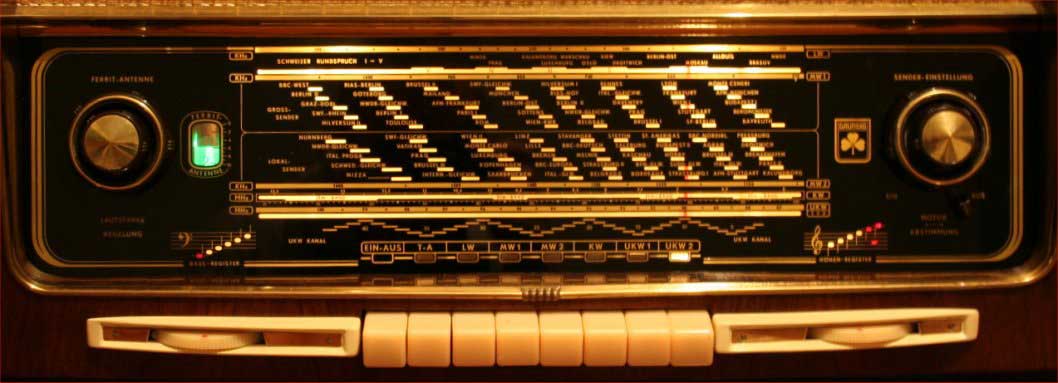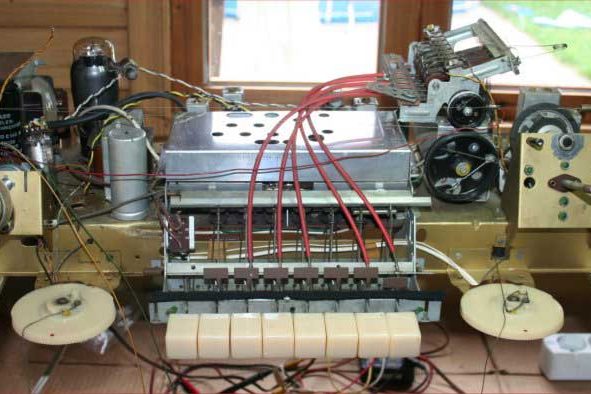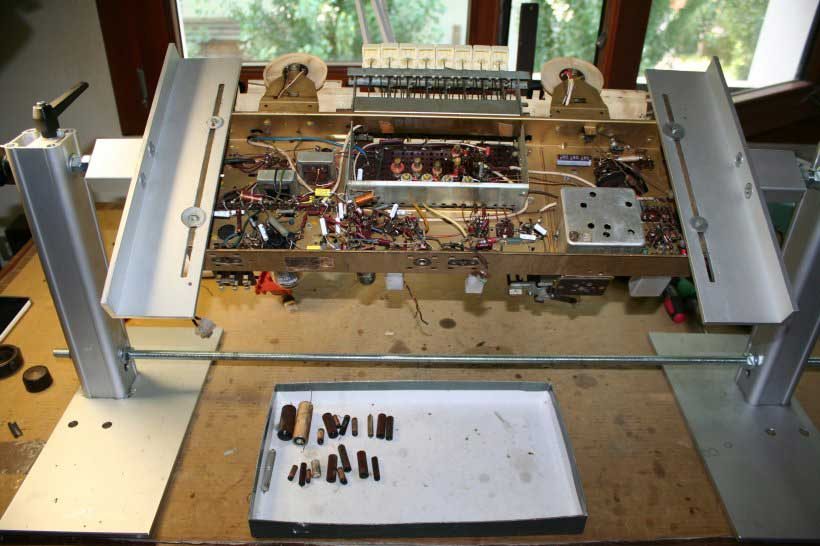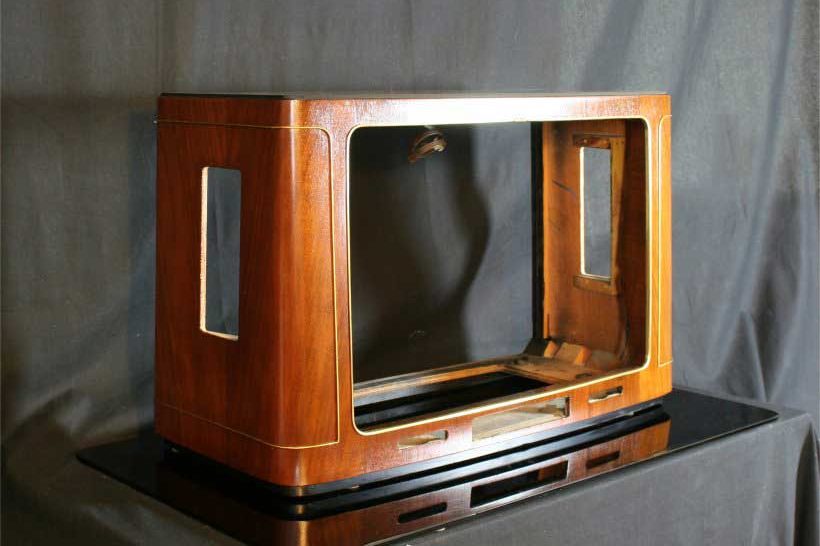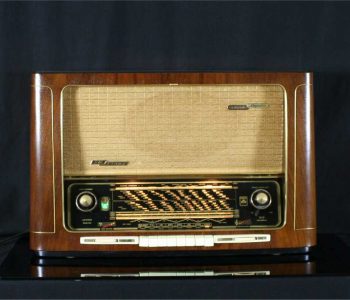 german radios - en
german radios - en
Grundig 4040W/3D – en
- 12th March 201724th April 2023
- by giovanni
Grundig 4040W/3D
GRUNDIG 4040W/3D
At first glance this Grundig looks like a regular high class device of the prestigious german brand. It is not like that.
3D
At that time Grundig was producing its three high class models: the 4040, the5040 and the 5050.
These devices were produced both in 3D with side loudspeakers and only with front loudspeakers.
Compared to front loudspeaker radios, 3D models are endowed with a strong depth effect as far as the sound image is concerned.
Motorized tuning
The three 3D system high class models were also equipped with a motorized tuning system.
It is clearly possible to manually tune the stations by employing the switch to exclude the motor.
The tuning mechanism is an authentic masterwork and it will be described as follows.
The video file (37,31 Mb), which can be downloaded, best shows the functioning of the 4040W/3D.
In those years Grundig began to intensely export its products to the USA. The demand got to such a high level that the joint-venture with the American brand Majestic was created.
Technical specifications of these devices were even stricter than those produced for the inner and the European market.
Grundig decided to produce devices that were suitable for European broadcasting systems while employing Majestic’s restrictive specifications. This 4040W/3D model is one of those rare Grundig/Majestic appliances
It is equipped with a double output transformer for low and medium-high frequencies.
Regular 4040W/3D used to be equipped with a single output transformer. The 4040W/3D has the powerful (18W) EL12 as its power tube.
Other than the electrostatic tweeter, the 4040W/3D has a huge elliptical multioctave woofer with a die-cast drum, which ensures a deep and sweet bass even with the central bass potentiometer (which I suggest).
Watching the big needle going through the scale of its own accord is extremely fascinating.
Due to its design and the robust piece of furniture, which works as a real loudspeaker, the sound of this device is extremely warm and well-rounded.
Further information about the extraordinary refinement of this device will be listed down below. A real delight both to be listened in on and to be seen.
Furthermore, its rareness makes of it a real collector’s item.
BLUETOOTH
Bluetooth receiver embedMULTI PLATFORM CONNECTION
Each radio is equipped with a cable for connection to any digital device.TUBESOUND IMPROVEMENT
- Bluetooth receiver embed - The unit is equipped with a BLUETOOTH receiver powered directly by the receiver power supply. This makes it possible to control the amplifier from any external digital device as an IPAD, a Smartphone, or a sophisticated multimedia station. So you can hear your preferred web station or your lossesless file without cables on the room. Wireless Receiver can be equipped upon requests.
- Multi Platform Connection - A customized adaptation cable to connect any digital device as Iphone, Smartphone, Laptop, CD Player etc. will be provided with this radio. This special cable suits the different impedances between the modern equipment and the receiver. Furthermore the two stereo channels flow into one without increasing the load to the input unit.
HISTORY
1930 - At 22 years old Max Grundig begin a radio repair business.
1939 - The II world War start. Grundig works primarily for the Wehrmacht and repair of telecommunication equipment.
1945 - Immediately after the war, the demand for repair work was very great. Max Grundig built the first two Grundig appliances: the Tubatest tube tester and the Novatest testing device.
1947 - Start the sale of a kit radio, the Heinzelmann. The unit is the basis of success, sold more than 15,000 pieces.
1950 - Very high frequency (VHF) is introduced to Germany and places new demands on the industry. Grundig launches the 380 W on the market.
1952 - The first television channel starts up in Germany. After intensive research, Grundig launches the FS 080 onto the market. In the same year the first portable tape recorder Reporter 500 L is created.
1956 - After a lot of radio produced with progrssively high performances was produced the Concert Radio 5080 equipped with an equaliser, which has five controls and a visual display.
1965 - A new factory is established in Braga, Portugal. The Satellit 205 is one of many appliances in the Satellit series. This product marks the beginning of Grundig production of high-quality global receivers.
1970 - The Audiorama 7000 Hi-fi was produced, it has twelve dynamic speaker systems in one speaker.
1976 - The Reel Tape Recorder TS 1000 is equipped for semi-professional use.
1980 - The slim-line Hi-fi Tuner ST 6000 and the Monolith Hi-fi Dynamic Flat Top Antenna, which has 22 speaker systems, are two particularly popular appliances in the new hi-fi range.
1984 - After severe drop in sales Philips increased its stake in Grundig 31.6 percent and takes over the corporate management.
1997 - Philips pulls out of its involvement with Grundig.
2003 - The company files for bankruptcy.
2008 - Turkey's Koç Holding took full ownership of Grundig Multimedia B.V., the parent company of Grundig Intermedia GmbH in Nuremberg.
Courtesy of: Grundig
MAIN FEATURES
Year of production: 1954
Superheterodyne IF 460/10700
11 AM Circuits
11 FM Circuits
Wavebands:
Medium Waves (OM), Long Waves (OL), Short waves (OC), FM (UKW)
Operating voltage (CA) 110; 125; 160; 220 Volts
4 Speakers:
1 Woofer
2 Midrange-Tweeters
1 Electrostatic Tweeter
Dimensions (LHD): 655 x 427 x 316 mm
Net weight: 18,5 kg
8 Tubes:
ECC85, EF89, EF89, ECC82, EBF80, EABC80, EL12, EM85
Optional module to receive the TV channels.
Rotating ferrite antenna for AM

TONE CONTROL WITH LEVEL INDICATION
The tones control system is very efficient. Above the large tone control knobs there is a band that lights up gradually indicating the emphasis on the band on which it acts.
A detail specific for “extreme” technical radios lovers: the high-tone control knob is linked to two thin ropes. One of them is for the position indicator of the control itself, whereas the other changes the position of the ferrite in the MF transformers modifying the inclination of the transformer’s curve.
By doing so high tones were attenuated/accentuated even before getting to the BF stage. Tone control was usually put into effect with the potentiometer on the tension amplifier stage.
AERIALS
Another refined feature: like other devices ( also lower class) the ferrite antenna is rotable and it can be activated through an external knob.
It places the antenna orthogonally in respect to the repeater so as to receive the highest signal. As far as this device is concerned the ferrite antenna is introduced through a switch, which is automatically switched on when the knob is turned. The latter is coaxial to the volume knob.
The position of the antenna can be read through the transparency of the magic eye. The resulting effect is amazing. When the antenna is disconnected you can read AUS on the magic eye.
Inside the case there is dipole for FM reception as well as an adjustable ferrite antenna for AM reception.
Remarkable is the perception of the reception with the inner antennas. The employment of an outer antenna ensure and unbelievably good perception. This device was indeed produced when there were a few and very far from each other radio stations.
TUNING SYSTEM
The tuning system is a real masterwork.
When the tuning switch is on AUS the tuning is manual as in regular devices.
When the automatic tuning switch is on EIN the current station is “mechanically” stored.
Example:
I pushed UKW2 and I am listening to a 89.90MHz station.
If I now push any of the other tuning buttons, the motor will take the pointer to the last listened station.
Pushing then UKW2 again the motor tunes exactly at 89.90 MHz.
The process can be repeated for any station on UKW1 UKW2 MW1 MW2 and LW bands.
The mechanical memorization is achieved through a number of frictions, springs, steel tie-rods and levers that require an accurate calibration.
Once calibrated and oiled, the mechanical system is extremely reliable and robust.
Its cogged wheels and flexible steel-blade frictions prevent any possible slid. A remarkable example of mechanical engineering.
TUNING INDICATOR
The tuning indicator has of course been replaced.

On the left you can find the volume control (with incorporated loudness) and the ferrite antenna’s rotation control.
You can see the antenna position indicator and behind that the magic eye. The AM scale for short, medium I and II and long waves.
FM I and II scale.
On the lower left side there are the ON/OFF, record player, the long, medium 1, medium 2, short waves, FM1 and FM2 tuning button.
Lastly the tuning knob is supported by a big fly-wheel which creates a pleasant movement.
The tuning switch is coaxial to the tuning knob and you can see the automatic/manual tuning switch.
Below there are the two bass and high control knobs.
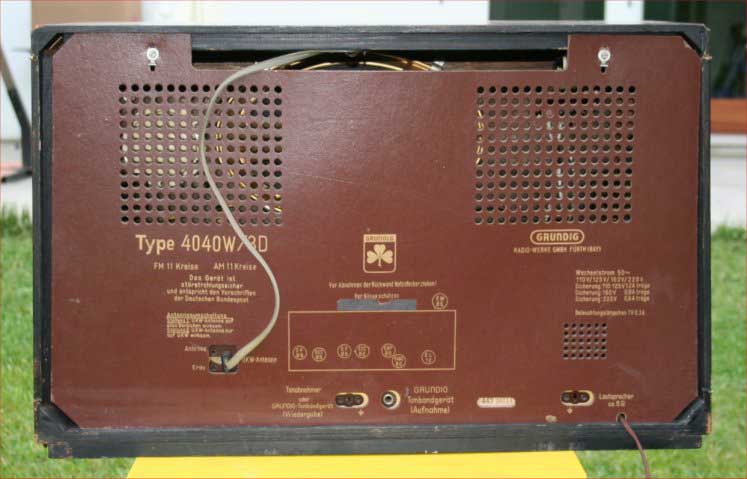
REAR SIDE
Output for external speakers.
Socket for recorder (tonbandgerat).
Turntable input (Tonabnehmer)
AM and FM aerial inputs and ground socket.
RESTORING WORKS
THE USUAL AMAZING LAST IMAGE







